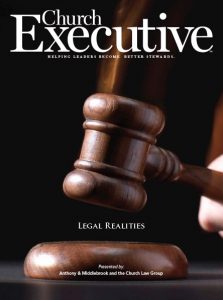
By David O. Middlebrook
![]() The purpose of bylaws is to reflect how your church operates, as well as to provide protection and structure. The bylaws contain a detailed framework of operations, and what seems important to the church in this season might not be in the next. So, you need to have a framework that can change.
The purpose of bylaws is to reflect how your church operates, as well as to provide protection and structure. The bylaws contain a detailed framework of operations, and what seems important to the church in this season might not be in the next. So, you need to have a framework that can change.
Bylaws contain the church’s internal rules and set forth the guidelines for operation. The bylaws could be described as a “rulebook.”
But, what goes in the bylaws?
Generally, bylaws should contain the following:
Name and Principal Office: The church’s name is obviously important since it will be used in contracts, intellectual property filings, registrations and business transactions. By filing the name as a corporation, it might also protect the name from being taken by another church. A principal location does not mean that the church cannot be moved or that it cannot establish multiple campuses, but it does at least provide some framework to establish its intended location.
 Statement of Faith: A Statement of Faith sets a church apart from other corporations by articulating beliefs or teachings with regard to religious matters. Putting the church’s basic beliefs or teachings into the bylaws helps create orthodoxy, reducing the likelihood of future dispute, and serves as a safeguard for the church.
Statement of Faith: A Statement of Faith sets a church apart from other corporations by articulating beliefs or teachings with regard to religious matters. Putting the church’s basic beliefs or teachings into the bylaws helps create orthodoxy, reducing the likelihood of future dispute, and serves as a safeguard for the church.
Autonomy: If your church is autonomous — that is, not under direct management or authority from a higher corporate organization or another church — it should be made clear in the bylaws. This provision has proven to be important for some churches who believed they were part of a voluntary association but later learn that the association did not consider the church free to disaffiliate from its authority.
Purposes: Having a section that describes the church’s intentions is important because it helps fulfill IRS expectations. The purpose section needs to firmly establish that the church has been created to engage in religious worship as well as other similar activities.
Powers and Restrictions: This is a governmental compliance section used to reaffirm that the church is allowed to do anything allowed under applicable law. We usually insert language expected by the IRS or demonstrates the church understands its requirement to follow certain laws.
Membership: It is important for your bylaws to outline the following facts about your members:
Does the church have members? If so, how does a person become a member? Who is responsible for verifying membership?
Do members get to vote on church business matters? If so, generally describe what those matters are and the process and procedures for voting.
When can a member be removed as a member, and how? And, if a member has been removed, how can he or she be reinstated?

Management: Leadership for daily church affairs needs to be clearly stated. Almost every church must have a Board of Directors or Trustees; however, this group may be called other names such as “Board of Elders” or “Leadership Team.”
Officers: The bylaws should address how officers are chosen and removed.
Independent Compensation Committee: The IRS expects to see the Independent Compensation Committee as a standing committee charged with reviewing and recommending the compensation for the church’s highest-paid employees.
Transactions and Policies: We usually have a section clearly reaffirming the church’s general business practices, in language consistent with IRS guidelines.
Books and Records: There needs to be requirements on who maintains the church’s books and records. While not required, the language should call upon the church to have an annual financial audit by a CPA.
Indemnification: In just about every jurisdiction, the church corporation has the authority to protect its officers and directors from liability claims based upon actions they took on the church’s behalf. We recommend adding an indemnification provision outlining this protection in your bylaws.
Alternative Dispute Resolution: It is usually not in the best interests of the church to be involved in lawsuits. To avoid public disputes and reputational harm, we recommend including a faith-based mediation and arbitration alternative provision within the bylaws.
How do I change our Bylaws?
If your church’s bylaws do not reflect how you operate — or perhaps you have learned they are not sufficient from a state law, federal tax compliance, or good governance perspective — where do you go from here?
The first step is to locate the current bylaws. You then must determine the procedures for amendments. You are generally required to follow the procedure articulated in your current documents until they are amended.
What about a Constitution?
Absent a requirement from a denominational authority requiring a church to maintain a constitution, we generally recommend that churches do not maintain the constitution as a third document. There are two reasons for this recommendation. First, state law only recognizes and defines the articles of incorporation and the bylaws. Second, the more documents that you have in place, the more likely they will not align. If that happens, members might be confused as to which document is controlling. This confusion can lead to discord and possible legal problems for the church.
The materials in this article are provided for informational purposes only and do not constitute legal advice. This article is intended, but not promised or guaranteed to be current, complete or up-to-date and should in no way be taken as an indication of future results. Transmission of the information in this article is not intended to create — and the receipt does not constitute — an attorney-client relationship between sender and receiver.
David O. Middlebrook is a founding shareholder of Anthony & Middlebrook and the Church Law Group in Grapevine, TX. His clients include high-profile charitable and religious organizations, both domestic and international.


